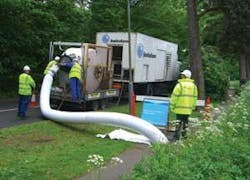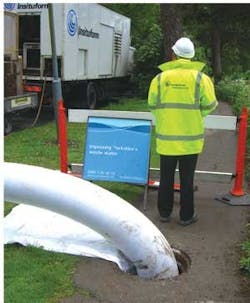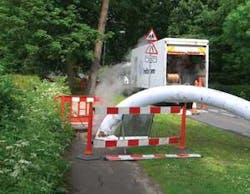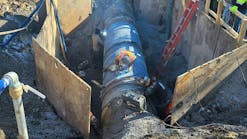A typical surface set up for a steam lining operation. Note just how small a footprint is required for the operational equipment.
Photo by Insituform Technologies Ltd.
Recognized advantages of the air inversion, steam cure system for pipeline lining is attracting much interest given the increasing number of projects.
By Ian Clarke
Insituform Technologies’ UK subsidiary, Insituform Technologies Ltd, has installed CIPP pipe linings that have been inverted using water for more than 30 years. But the pipeline rehabilitation company has recently adopted a new technology that uses compressed air inversion and steam curing to install linings to smaller diameter pipelines because of its proven benefits.
The traditional water pressure head that powers the established CIPP inversion technique is achieved by building a scaffold tower to hold the open end of the lining above the level of the pipe. After inversion, water in the lining is heated to initiate the curing of the liner resin. More recently, Controlled Head Inversion Pressure (CHIP) units have been used where water pressure comes from a ground level pump, but the system operation is similar. Water inversion and hot curing has been used to reliably install many thousands of kilometers of liners all over the world, but there have always been certain problems to overcome. Steam lining now offers a new technology that is particularly suited to smaller diameter pipelines.
Small diameter linings need high pressures to make them invert, a factor that sometimes involves scaffold towers of 10- to 12-m-high. The water supply flow rate governs the inversion rate. In addition, heating large volumes of water requires large amounts of energy, yet this energy must be removed using cold water once the resin is cured. Transporting several tonnes of water to, and increasingly from, the job site often entails the use of tanker trucks and dedicated personnel. So contractors can offer more competitive installation costs in a market largely driven by price, if the use of water is eliminated.
The liner passing through the manhole during the inversion process.
Photo by Insituform Technologies Ltd.
Using air instead of water to install a lining has many advantages. An average compressor can give around five cubic meters of air per minute. So to fill 100 m of 305- mm-diameter lining to 1 bar pressure takes less than three minutes -- a feat simply not possible with water. Air is also 5,000 times easier to heat than water to the point where to heat air from 20°C to 80°C takes just 0.82 J/l as against some 4,187 J/l for water.
Benefits of steam
Steam, however, is better than air at transmitting heat. Steam is controllable and allows linings to be heated to over 100°C. The advantage of this is that liner resins cure twice as quickly for every 9°C rise in temperature. For example, if a liner is normally cured for four hours at 80°C, the same degree of cure can be obtained from curing for two hours at 89°C, or one hour at 98°C. In practice, only the inside face of the resin reaches these temperatures; the outside of the resin is cooled by contact with the host pipe. So, on steam cured linings, temperatures are held at between 110°C to 120°C for one hour, just to be on the safe side. This is still much quicker than anything achievable with water-cured linings.
Another key benefit of air inversion with steam curing is that the installation and curing units are separate items. With water-based linings it is necessary to keep the tower or CHIP unit in place until the linings have been cured and cooled. Once a tube has been installed with air, the launcher can be removed, reloaded, and redeployed on the next section of pipe at the same time as the first one is being cured. This increases the time saved by the quicker curing process.
A typical lining for a 100-m-length of 305-mm-diameter job might be timed as follows. Once cleaning, CCTV and bypass arrangements have been completed, load the lining into launcher (30 minutes). Second, close the launcher and position the launch elbow in the manhole (30 minutes). Third, invert the liner (10 minutes). Fourth, fix the steam hoses to the liner ends (30 minutes); Fifth, cure and cool down (two hours). Finally, cut the liner ends (30 minutes). This lining required four hours and 10 minutes.
During Insituform’s multiple lining contracts carried out in the field, the launcher has been made available to line a second pipe after just one hour and 40 minutes. This allows the second lining to be inverted and ready for curing just two hours later, or just in time for the steam boiler to finish curing the first pipe. In this way, two linings were completed in just six hours and 40 minutes. In addition, this process requires much less water usage than with a water inversion system and much less water to dispose.
Steam venting during the liner curing process.
Photo by Insituform Technologies Ltd.
Another benefit is that the water circulation hose is unnecessary. Once the lining has cooled and the ends cut off, the job is done. No hose needs to be pulled out and no scaffold tower to dismantle and load into a truck.
Steam systems also provide for less disruption per job site due to the faster installation and cure times. The use of steam curing also creates less in the way of styrene levels and odors; consequently the potential for pollution in the sewer system and customer complaints is greatly reduced.
Disadvantages
No engineering system is perfect. Some factors limit the use of air and steam cure systems. Linings installed with water effectively float through themselves as the inversion proceeds, so there is no limit to how long a single inversion can be. Air-inverted linings must fit inside the launcher drum and are subjected to much more friction and drag during the inversion process. Consequently, higher pressures must be used for longer linings. Up to 250 m is possible per air inversion in small diameter pipes.
Also, the steam system relies on turbulence to heat the lining evenly during curing, which limits the capability to small- and medium-diameter pipes only (up to about 400 mm). These limits may be increased with further development and applications.
Recent projects
Insituform has used the air inversion, steam lining system in many projects in the UK within the past two years, including Sheffield, Yorkshire and Nailsworth, Gloucestershire.
The Sheffield project, at a site known as Roscoe Bank for client Yorkshire Water, was completed as a subcontract to Yorkshire Water’s main contractor, Watermark. The work comprised the rehabilitation of a 300-mm diameter sewer running beneath woodland in the city that had previously been responsible for a pollution incident that affected a nearby fish farm. Root intrusions and other defects were believed to be the cause of the problem. The sewer, whilst accessible from both ends, was not accessible to plant over its mid-section and included a 16-m-fall from one end to the other.
Air inversion, steam cure lining was chosen for this site for a variety of reasons. The limited plant requirement allowed greater off-road access to the main working sites and simpler upstream installations. Four liners were installed, three prior to Christmas 2005 under a road closure, with the fourth liner being installed in early 2006 using temporary traffic light control to keep the road open. Access restrictions meant that only one liner was installed per day.
Preparation work for the site included root removal from the host sewer; diversion establishment due to the required road closure; negotiations for private land access to some manholes; liaison with the local council for tree protection purposes; and the location and exposure of four buried manholes.
The final liner installed was a 146-m-long liner over a 2.8-m-fall and is the most voluminous installation completed to date, and the first installation to be completed over such a steep fall.
If the air inversion, steam lining system was not available for this project, the use of a water- and heat-based system would have meant an increased time on site and a subsequently higher cost to the client, as well as increased disruption to the surrounding area.
Another interesting project was carried out about one year earlier in Nailsworth. This project, for client Severn Trent Water, was done as a subcontract to GF Tomlinson, Severn Trent’s main contractor. The project required the rehabilitation of some 144 m of a 150-mm diameter combined sewer running beneath gardens and grazing pasture near the town. A survey of the pipe had exposed existing fractures and the lining was required to prevent future root ingress at these defect points. The project comprised the installation of two separate liners, of 59-m and 85-m-length respectively.
The advantage of the steam cure system in this project was access. The installations were located some 60 m from the nearest hard stand position where plant could be safely situated. The surrounding ground was generally soft material, so vehicles could not directly access the installation points, which were positioned in manholes in the middle of a field. To lay a hot water cure feed pipe over this distance, would have meant significant heat losses before the water even entered the liner, requiring a major increase in heating costs and curing time. Using the steam generator eliminated much of this energy cost and additional time on site. Both liners were successfully installed in a single day, whereas it is estimated that the work would have taken upwards of three days to complete if hot water curing had been used.
The liners also had to negotiate bends in the host pipe, obstacles best overcome using the steam system. The reduced styrene levels associated with the system were also advantageous due to the site locality near residential buildings.
The air inversion, steam cure system has also been successfully used across the Anglian Water district and its application range has grown continually over the past several months. This growth is expected to continue for the foreseeable future.
Author’s Note
Ian Clarke of NoDig Media Services is based in Crewkerne, UK, and can be reached by email at: [email protected]. For further information on the Insituform Technologies Ltd Steam Lining system, please visit Stand 247a t No-Dig Live 2006 between September 26 and 28 at Stoneleigh Park, UK, or visit the company website: www.insituform.com.





